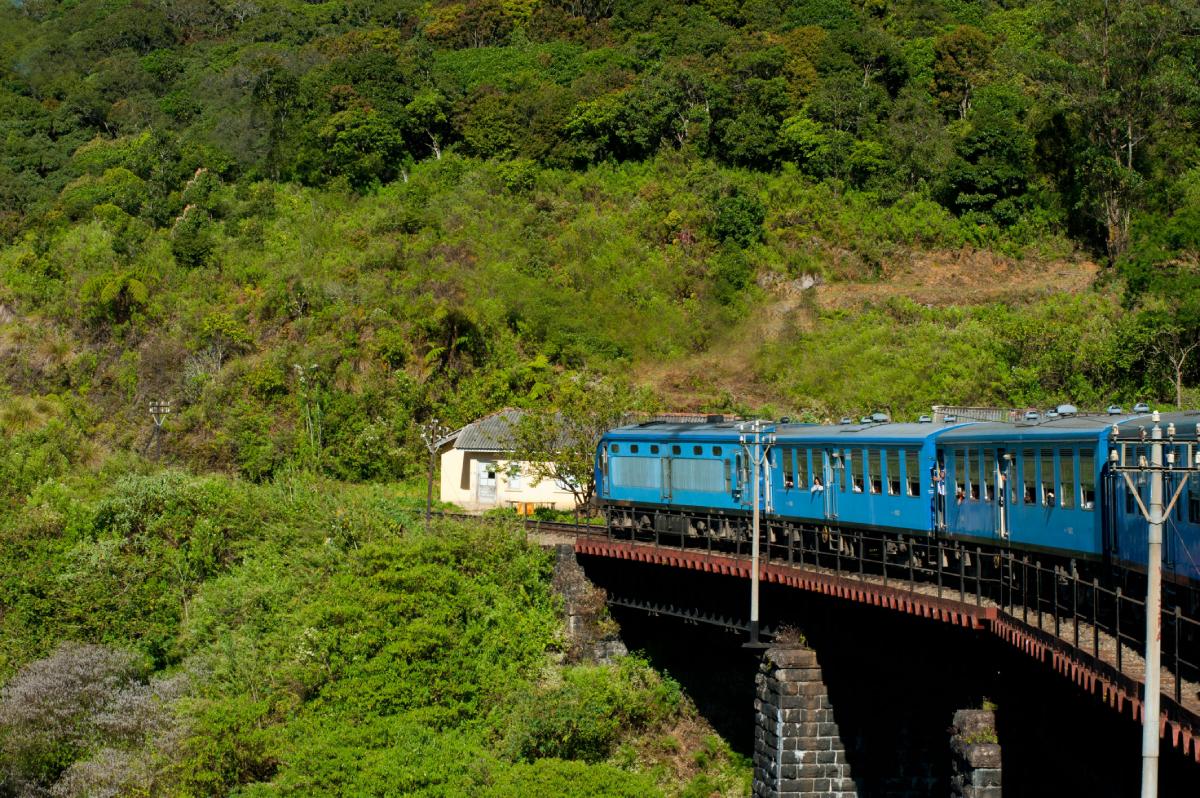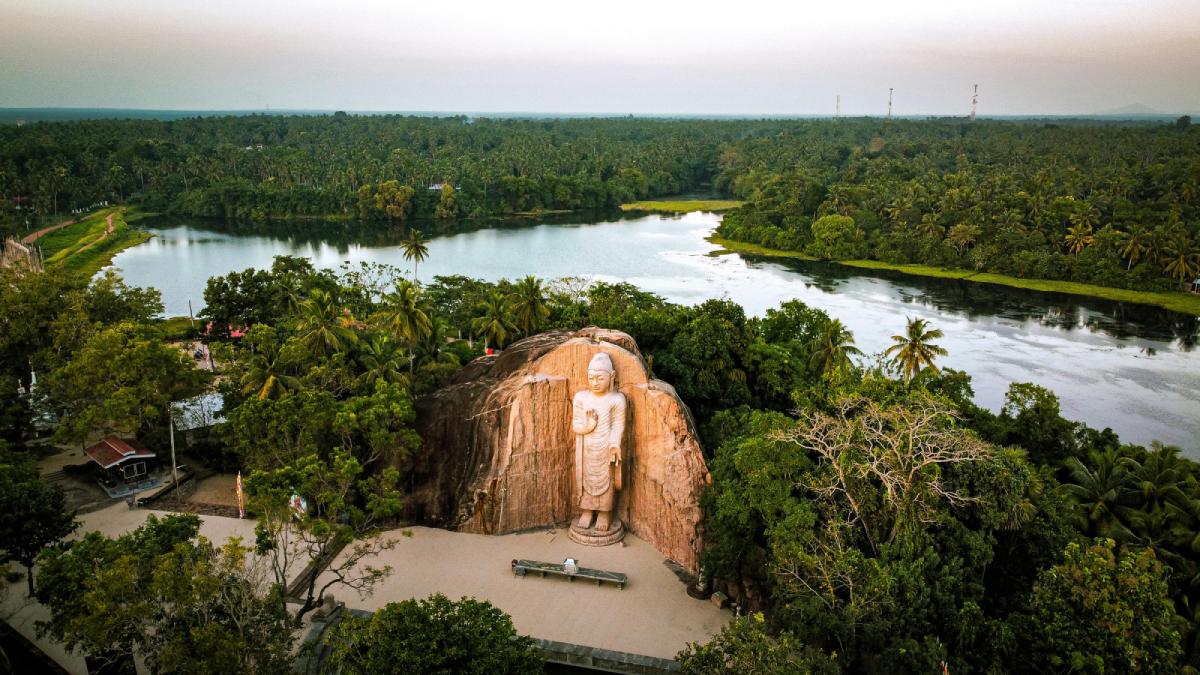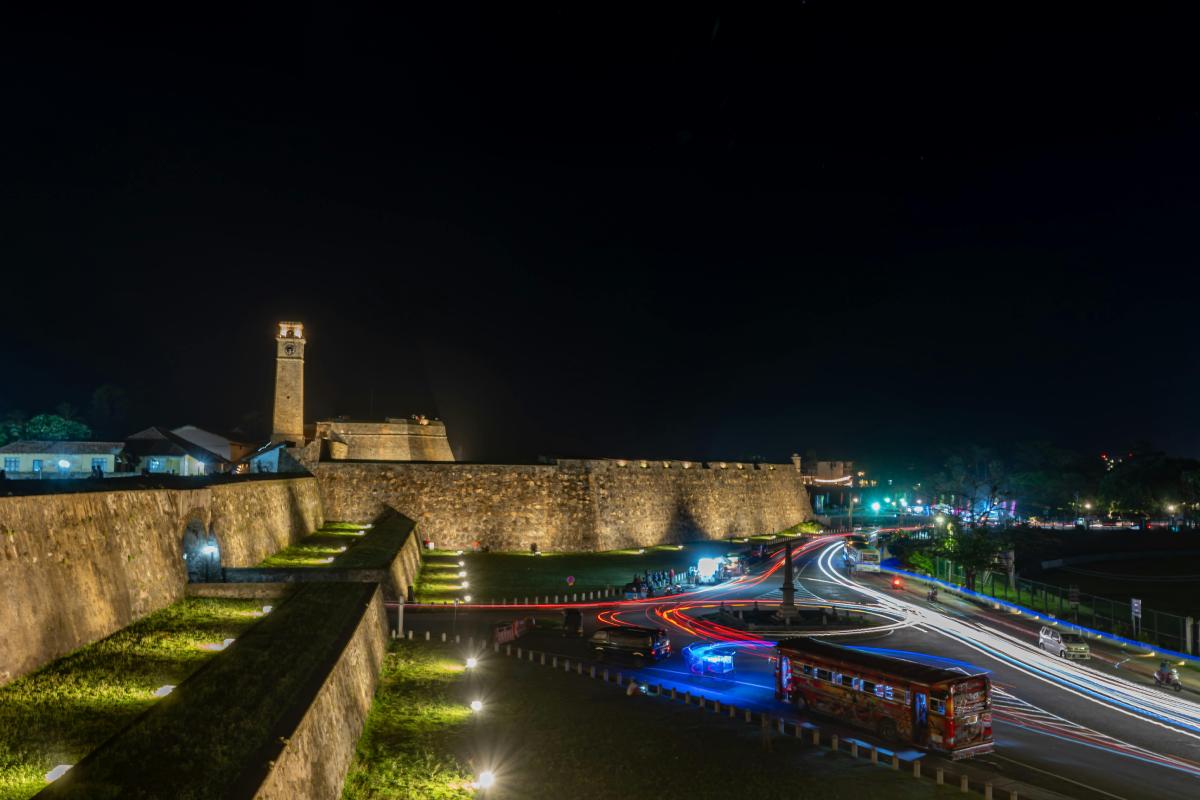Ella Nine Arch Bridge stands as one of Sri Lanka’s most captivating natural wonders – a testament to nature’s architectural prowess hidden within the lush highlands of the island nation. This magnificent stone arch bridge, spanning approximately 25 meters across a deep ravine, has become an iconic symbol of Sri Lanka’s natural beauty and a must-visit destination for travelers seeking breathtaking landscapes.
Origins and Geography
Nestled in the picturesque hill country of Sri Lanka near the small town of Ella, Nine Arch Bridge (also called Ella Nine Arch) is situated approximately 3,100 feet above sea level. The bridge connects two hills and crosses a valley of dense tropical forests, tea plantations, and small villages.
The bridge’s unique name derives from its distinctive architectural feature – nine perfectly symmetrical arches that support the railway track above. These massive brick and cement arches rise dramatically from the valley floor, creating an impressive silhouette against the surrounding greenery.
Architectural Marvel, Ella Nine Arch Sri Lanka
What makes Nine Arch Bridge particularly remarkable is the story behind its construction. Built between 1913 and 1921 during the British colonial period, the bridge was designed as part of the railway line connecting Badulla and Colombo. The most fascinating aspect of its construction is that it was completed entirely without steel reinforcements – a rarity for a structure of this size and importance during that era.
The bridge stands approximately 30 meters tall and spans about 91 meters in length. Its construction primarily used local materials:
- Dense blocks of stone
- Brick
- Cement
Colonial engineers and local craftsmen worked together to create this enduring structure that has withstood over a century of monsoon rains, tropical weather conditions, and daily train crossings. The precision of its construction becomes even more impressive considering the limited technology available at the time.
Historical Significance
Nine Arch Bridge emerged during a pivotal period in Sri Lanka’s history. The British colonial administration had invested heavily in developing Sri Lanka’s (then Ceylon’s) railway infrastructure to facilitate the transportation of tea from the highland plantations to Colombo’s port for export.
The railway line that traverses Nine Arch Bridge was part of the extensive railway network that transformed Sri Lanka’s economy and landscape during the early 20th century. This particular section, winding through challenging mountainous terrain, represented an engineering triumph that connected previously isolated communities to the broader economic and social fabric of the country.
Local legends add another fascinating dimension to the bridge’s origin story. According to folklore, when World War I began, steel allocated for the bridge’s construction was requisitioned for war efforts. Rather than abandoning the project, engineers and local builders adapted by designing a bridge that could function without steel reinforcements, relying instead on traditional masonry techniques.
Cultural Importance
Over decades, Nine Arch Bridge has transcended its utilitarian origins to become deeply embedded in the cultural identity of the region. For local communities, the bridge represents more than just a transportation link – it symbolizes connectivity, resilience, and the harmonious integration of human achievement with natural surroundings.
The bridge has featured prominently in Sri Lankan literature, poetry, and art, often symbolizing the bridge between colonial past and independent present, or between modern development and natural preservation. Its distinctive silhouette has become one of the most photographed and recognized landmarks in Sri Lanka, appearing on postcards, travel brochures, and even currency notes.
For the residents of Ella and surrounding villages, the daily passing of trains across the bridge marks the rhythm of daily life. Local economies have developed around tourism to the site, creating livelihoods for guides, photographers, cafe owners, and souvenir sellers.
Tourism Experience
Today, Nine Arch Bridge ranks among Sri Lanka’s top tourist attractions. Visitors trek through tea plantations and forest paths to reach various vantage points offering spectacular views of the bridge. The most popular viewing spots include:
- Valley Floor – Looking up at the massive structure from below provides a dramatic perspective of its scale and grandeur.
- Hillside Viewpoints – Several paths lead to elevated positions that offer panoramic views of the bridge and surrounding landscapes.
- Railway Track – Some adventurous visitors walk along the track itself (though safety precautions are essential, especially when trains are expected).
The bridge experience is particularly magical during early morning hours when mist often shrouds the valley, gradually revealing the bridge as the sun rises. Another popular time to visit is when trains cross the bridge, usually several times daily. The sight of the bright blue or red government-operated trains slowly traversing the curved track against the backdrop of green hills creates a perfect photographic moment that captures the essence of Sri Lanka’s highlands.
Local entrepreneurs have established small cafes and viewing platforms where visitors can wait comfortably for trains to pass while enjoying Ceylon tea grown in neighboring plantations.
Environmental Context
The environmental setting of Nine Arch Bridge contributes significantly to its appeal. The structure is surrounded by a biodiverse ecosystem that includes:
- Dense tropical forests with endemic plant species
- Terraced tea plantations that create geometric patterns on hillsides
- Small-scale agricultural plots cultivated by local farmers
- Streams and waterfalls that flow through the valley below
This rich natural context has raised important conversations about sustainable tourism and environmental preservation. As visitor numbers have increased dramatically over the past decade, local authorities and community organizations have implemented measures to protect the surrounding ecosystem while still allowing access to this remarkable site.
Conservation efforts include designated viewing areas to prevent erosion, waste management systems, and community-led initiatives to educate visitors about the ecological significance of the area. These efforts represent an ongoing balancing act between promoting tourism and preserving the natural beauty that attracts visitors in the first place.
Engineering Legacy
From an engineering perspective, Nine Arch Bridge continues to fascinate experts. Its endurance without steel reinforcement demonstrates principles of traditional masonry that modern engineers still study. The perfect semicircular arches distribute weight efficiently, while the massive stone piers provide stability against lateral forces from wind and train movements.
Railway engineers conduct regular inspections and maintenance, ensuring that this centenarian structure remains safe for daily use. The bridge exemplifies sustainable infrastructure design – built primarily from local materials, requiring minimal technological intervention for maintenance, and serving its original purpose continuously for over 100 years.
Engineering schools in Sri Lanka often use Nine Arch Bridge as a case study in civil engineering courses, analyzing its design principles, construction techniques, and longevity factors. The bridge stands as testimony to the notion that thoughtful engineering that works with natural environments can create lasting infrastructure that becomes harmoniously integrated with its surroundings.
Photographic Fame
In recent years, social media has amplified Nine Arch Bridge’s global recognition. The structure’s photogenic qualities – its perfect arches framed by lush vegetation, the dramatic height above the valley floor, and the nostalgic charm of colonial-era trains passing over it – make it extraordinarily popular on visual platforms like Instagram.
Professional photographers travel specifically to capture the bridge in various lighting conditions and seasons. The most iconic images typically feature:
- Morning mist swirling around the arches
- Silhouettes at sunset with dramatic sky backgrounds
- Trains crossing with passengers waving from windows
- The contrast between the structured geometry of the bridge and the organic forms of surrounding nature
This photographic fame has contributed significantly to tourism growth in the region and has made the bridge instantly recognizable worldwide as a symbol of Sri Lanka.
Practical Visitor Information
For travelers planning to visit Nine Arch Bridge, several practical considerations enhance the experience:
- Best visiting times: Early morning (6-8 AM) for misty atmospheric conditions and afternoon (3-5 PM) for golden light photography
- Train schedules: Trains typically pass the bridge several times daily, with schedules available at Ella Railway Station (though delays are common)
- Access routes: Multiple paths lead to the bridge, ranging from easy 15-minute walks from nearby roads to more challenging 45-minute hikes through tea plantations
- Local guides: Hiring local guides provides cultural context and ensures finding the best viewing locations
- Weather considerations: Monsoon seasons (May-September and December-February) bring heavy rainfall that can make paths slippery but also create dramatic misty conditions
Visitors should practice responsible tourism by staying off the tracks when trains approach, respecting local properties and tea plantations, and carrying out any waste they generate.
Future Preservation
As tourism continues to grow, questions about preservation and sustainable development surround Nine Arch Bridge. The structure itself remains an active part of Sri Lanka’s railway infrastructure while simultaneously serving as a heritage site and tourist attraction.
Local authorities have begun implementing management plans that address several priorities:
- Structural preservation of the historic bridge
- Safety measures for visitors exploring the area
- Environmental protection of the surrounding ecosystem
- Economic opportunities for local communities
- Cultural heritage education
Community-based tourism initiatives increasingly involve local residents in decision-making processes about how the site is managed and how benefits from tourism are distributed. These participatory approaches aim to ensure that Nine Arch Bridge remains both a functioning piece of infrastructure and a sustainable attraction that benefits local communities.
Beyond the Bridge: Exploring Ella
Many visitors discover that Nine Arch Bridge serves as an excellent introduction to the broader attractions of Ella and Sri Lanka’s hill country. The region offers numerous complementary experiences:
- Ella Rock and Little Adam’s Peak – Hiking destinations with panoramic mountain views
- Tea Factory Tours – Opportunities to learn about Ceylon tea production
- Ravana Falls – A scenic waterfall associated with the Ramayana epic
- Traditional Cuisine – Local restaurants serving authentic Sri Lankan highland cuisine
- Boutique Accommodations – From eco-lodges to colonial bungalows converted into hotels
These diversified tourism offerings help distribute visitor impact beyond the bridge alone and provide more comprehensive experiences of local culture and environment.
Conclusion
Ella Nine Arch Bridge represents far more than just an impressive feat of engineering or a photogenic landmark. It embodies the complex interplay between colonial history and local craftsmanship, between infrastructure development and natural preservation, and between global tourism and local community sustainability.
As this magnificent structure enters its second century, it continues to inspire awe in visitors from around the world while serving as a vital transportation link for local communities. The enduring appeal of Nine Arch Bridge lies in this multifaceted significance – simultaneously a functional railway bridge, a historic monument, a natural wonder, and a cultural symbol.
For travelers seeking meaningful encounters with Sri Lanka’s history, culture, and natural beauty, Ella Nine Arch offers a perfect synthesis – a human achievement that enhances rather than diminishes its natural setting, creating a harmonious whole greater than the sum of its parts. The nine perfect arches spanning the valley stand as silent witnesses to history while continuing to connect people and places in the present, making this structure not just a bridge across physical space but across time itself.


